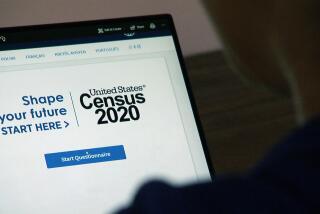Second Count May (or May Not) Resolve Census Doubts
- Share via
Census takers in 1990 will have two bites at the apple, two chances to make a complete count of an increasingly invisible population, thanks to the settlement this week of a lawsuit against the U.S. Census Bureau.
At first blush, the prospect of such a novel census is good news for cities such as Los Angeles that have believed for years that the census has under counted its residents, probably causing the city to be shortchanged politically and financially.
Officials warn, however, that next year’s second count does not guarantee that Los Angeles or any other cities with many immigrants, homeless people, transient poor and other hidden residents will get what they wanted when they sued.
“It’s not manna from heaven. There are problems with it,” said Deputy City Atty. Jessica Heinz, who represented Los Angeles in the lawsuit.
The settlement of the lawsuit brought by several large cities, including Los Angeles, requires the use of a supplementary counting technique designed especially for densely populated areas of large cities where the standard enumeration has tended to miss many people.
Heinz and others involved in the lawsuit point to two potential problems that could compromise the second count and dim the cities’ hopes of getting credit for more people.
Under terms of the settlement, the second count, or post-enumeration survey as it is known, will make estimates of the national population based on a sample of 150,000 households. The demographers who developed the technique said it should be based on a sample of 300,000 households.
Bureau officials argued that the cost of sampling 300,000 households would divert too much money from other census work.
In the wake of the settlement, there is disagreement among demographers over whether the smaller sample will be detailed enough to be useful in reapportionment, said Jim Wisely, a demographic consultant to Assembly Speaker Willie Brown.
According to Wisely, the survey might find more people living in Los Angeles than the initial census count, yet not be able to pinpoint where the people live. In that case, the city would be hard pressed to draw new congressional or legislative districts and the political advantages of a larger population might be squandered.
Timing is the second problem with the post-enumeration survey. Census Bureau officials say it won’t be completed until July of 1991, several months after the first census numbers are, by law, turned over to Congress and the states. Even though the first set of numbers, based on the initial count, will carry a warning that they may be subject to change, there is no guarantee that the process of reapportionment will not be well under way before the second set of population numbers is available to Congress.
Moreover, the settlement of the lawsuit provides no assurance that Secretary of Commerce Robert Mosbacher will not throw out the results of the post-enumeration survey and simply rely on the first set of numbers. In other words, the 1990 census will be business as usual if Mosbacher decides that the traditional head count is the most reliable technique, despite its history of missing large numbers of minorities, poor people and immigrants who do not speak English.
A panel of eight experts will be chosen to help Mosbacher make up his mind about the quality of the post-enumeration survey. Four of its members are to be picked by plaintiffs in the lawsuit against the Census Bureau. But Mosbacher is not bound to abide by the panel’s advice.
Despite the uncertainties, the newly refined 1990 census is still considered progress by critics of the old methods.
“I think Los Angeles is going to benefit. At least there will be an effort this time to find out who was missed and to correct the numbers in a timely fashion. There are problems, but overall, I think it is real good news for us,” said Leo Estrada, a professor of urban planning at UCLA and a former chairman of the Latino advisory committee to the census.
Four Months Later
The post-enumeration survey, which has been championed by Estrada and other minority advisers to the census, would begin four months after census takers begin mailing out the traditional questionnaires that the initial head count is based on.
The survey would bring census employees back to 150,000 households where the questionnaires were sent. The households would be picked from among 100 strata of American society.
For example, one of the strata might consist of black renters living in multifamily dwellings, said Charles Jones, associate director of the decennial census.
Jones said that within each of the 100 strata, a random sample of 1,500 households will be interviewed to find out how many people live there as well as other information normally collected during a census. The information culled from the interviews will be compared with the information acquired from the initial questionnaires. The Census Bureau will then be able to adjust up or down the official number of people living in each targeted household.
Difficulties in Count
Relying on sampling and mathematical modeling, the survey technique grew out of demographers’ belief that it is impossible to conduct a head count in a nation of more than 200 million people, many of whom can’t be found or don’t want to be found.
More to Read
Sign up for Essential California
The most important California stories and recommendations in your inbox every morning.
You may occasionally receive promotional content from the Los Angeles Times.













